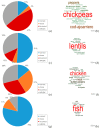Dishes Adapted to Dysphagia: Sensory Characteristics and Their Relationship to Hedonic Acceptance
- PMID: 33672336
- PMCID: PMC7926527
- DOI: 10.3390/foods10020480
Dishes Adapted to Dysphagia: Sensory Characteristics and Their Relationship to Hedonic Acceptance
Abstract
Dishes whose texture has been modified for dysphagia undergo changes in other sensory characteristics as well. Therefore, it is necessary to identify these characteristics in adapted dishes and their relationship to hedonic acceptance. In the present work, the sensory characteristics of five dishes adapted to dysphagia associated with cerebral palsy were investigated using the check-all-that-apply method. A hedonic evaluation with a panel of non-dysphagic judges was performed to relate the degree of acceptance with the sensory characteristics of the adapted dishes. The identification of the original non-adapted dish as well as the relationship between the hedonic evaluation by non-dysphagic judges and dysphagic judges were explored. The main attributes of the dishes adapted to dysphagia were "homogeneity" and "easy-to-swallow". Attributes that increased the hedonic evaluation were "flavorful", "flavor of the original dish", "soft texture", "easy-to-swallow", and "odor of the original dish". The attributes that decreased the hedonic evaluation were "thick mash" and "bland". The fish dish was the only one correctly identified more than 62.5% of the time. The adapted dishes received scores above 4.7 out of 9.0 in the hedonic evaluation. The most accepted dishes were the chicken stew and the chickpea stew. Except for the pasta dish, the test yielded similar results to those obtained with dysphagic judges. The texture-modified dishes were correctly characterized and accepted. This study shows that all the sensory characteristics of the adapted dishes are crucial for acceptance and identification.
Keywords: acceptability; adapted dish; check-all-that-apply; dish identification; sensory characteristics; texture-modified.
Conflict of interest statement
The authors declare no conflict of interest.
Figures







Similar articles
-
Texture-Modified Food for Dysphagic Patients: A Comprehensive Review.Int J Environ Res Public Health. 2021 May 12;18(10):5125. doi: 10.3390/ijerph18105125. Int J Environ Res Public Health. 2021. PMID: 34066024 Free PMC article. Review.
-
Sensory Features, Liking and Emotions of Consumers towards Classical, Molecular and Note by Note Foods.Foods. 2021 Jan 10;10(1):133. doi: 10.3390/foods10010133. Foods. 2021. PMID: 33435148 Free PMC article.
-
How can restaurants entice patrons to order environmentally sustainable dishes? Testing new approaches based on hedonic psychology and affective forecasting theory.J Sustain Tour. 2023 Oct 25;32(10):2225-2244. doi: 10.1080/09669582.2023.2274283. eCollection 2024. J Sustain Tour. 2023. PMID: 39372039 Free PMC article.
-
Hedonic evaluation and check-all-that-apply (CATA) question for sensory characterisation of stewed vegetable Amaranthus.J Food Sci Technol. 2020 Feb;57(2):454-462. doi: 10.1007/s13197-019-04073-1. Epub 2019 Sep 4. J Food Sci Technol. 2020. PMID: 32116355 Free PMC article.
-
Recent development in the application of alternative sterilization technologies to prepared dishes: A review.Crit Rev Food Sci Nutr. 2019;59(7):1188-1196. doi: 10.1080/10408398.2017.1421140. Epub 2018 Jan 23. Crit Rev Food Sci Nutr. 2019. PMID: 29359947 Review.
Cited by
-
Desserts Enriched with a Nanoemulsion Loaded with Vitamin D3 and Omega-3 Fatty Acids for Older People.Foods. 2024 Jun 29;13(13):2073. doi: 10.3390/foods13132073. Foods. 2024. PMID: 38998579 Free PMC article.
-
Nutritional quality of dysphagia-oriented products sold on the Italian market.Front Nutr. 2024 Jul 3;11:1425878. doi: 10.3389/fnut.2024.1425878. eCollection 2024. Front Nutr. 2024. PMID: 39021607 Free PMC article.
-
Texture-Modified Food for Dysphagic Patients: A Comprehensive Review.Int J Environ Res Public Health. 2021 May 12;18(10):5125. doi: 10.3390/ijerph18105125. Int J Environ Res Public Health. 2021. PMID: 34066024 Free PMC article. Review.
-
Dietary Habits, Food Product Selection Attributes, Nutritional Status, and Depression in Middle-Aged and Older Adults with Dysphagia.Nutrients. 2022 Sep 28;14(19):4045. doi: 10.3390/nu14194045. Nutrients. 2022. PMID: 36235698 Free PMC article.
-
Comparison of Check-All-That-Apply (CATA), Rate-All-That-Apply (RATA), Flash Profile, Free Listing, and Conventional Descriptive Analysis for the Sensory Profiling of Sweet Pumpkin Porridge.Foods. 2023 Sep 25;12(19):3556. doi: 10.3390/foods12193556. Foods. 2023. PMID: 37835209 Free PMC article.
References
-
- Hastorf C.A. The Social Archaeology of Food: Thinking about Eating from Prehistory to the Present. Cambridge University Press; Cambridge, UK: 2016. The practices of a meal in society; pp. 55–80.
Grants and funding
LinkOut - more resources
Full Text Sources
Other Literature Sources

